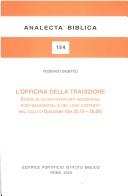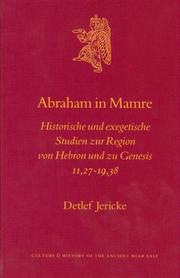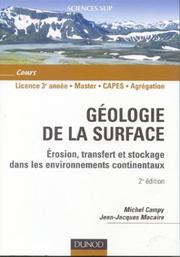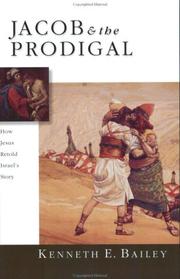| Listing 1 - 10 of 26 | << page >> |
Sort by
|

ISBN: 8876531548 9788876531545 Year: 2003 Volume: 154
Abstract | Keywords | Export | Availability | Bookmark
 Loading...
Loading...Choose an application
- Reference Manager
- EndNote
- RefWorks (Direct export to RefWorks)
Book
ISBN: 3788719435 Year: 2003 Publisher: Neukirchen-Vluyn Neukirchener
Abstract | Keywords | Export | Availability | Bookmark
 Loading...
Loading...Choose an application
- Reference Manager
- EndNote
- RefWorks (Direct export to RefWorks)
Book
ISBN: 2855570840 Year: 2003 Publisher: Paris : Editions France Agricole,
Abstract | Keywords | Export | Availability | Bookmark
 Loading...
Loading...Choose an application
- Reference Manager
- EndNote
- RefWorks (Direct export to RefWorks)
soil chemicophysical properties --- soil chemicophysical properties --- Soil biology --- Soil biology --- soil genesis --- soil genesis --- ecology --- ecology

ISBN: 9789004496736 9789004129399 Year: 2003 Publisher: Leiden; Boston : BRILL
Abstract | Keywords | Export | Availability | Bookmark
 Loading...
Loading...Choose an application
- Reference Manager
- EndNote
- RefWorks (Direct export to RefWorks)
This volume deals with historical and exegetical problems of the Abraham story in the book of Genesis. The first part describes the results of archaeological investigations at Hebron and Mamre in Southern Palestine including remarks on the status of the province of Judah in the first millennium BCE, especially in the Babylonian and Persian period. The second part presents exegetical comments on Genesis chapter 13 and 18. The concluding part of the volume relates the historical and exegetical aspects. The Abraham story is interpreted as a product of the Judaean people of the Babylonian and Persian Period.
Biblical Archeology --- Exegesis --- Genesis (Bible book) --- Geography --- Historical geography
Dissertation
Year: 2003
Abstract | Keywords | Export | Availability | Bookmark
 Loading...
Loading...Choose an application
- Reference Manager
- EndNote
- RefWorks (Direct export to RefWorks)
The natural background levels of metallic trace elements (MTEs) in cultivated soils should be known in order (i) to understand the processes in which MTEs are involved and (ii) settle a reference system dedicated to the appraisal of agricultural practices, to the detection of contaminations, or to the time-course follow-up of regional values. A methodological framework has thus been set up to evaluate the importance of natural driving factors, the pedogeochemical background, of the spatial distribution of MTEs in soils and also to compare the current levels of MTEs content in agricultural soils from the Loamy Region with natural values. As main results from the study of parent materials, (i) lithological units are now characterized with element content signatures, (ii) the prominent part of clay, total iron, and total aluminium contents as driving factors of the content in MTEs has been measured, and (iii) the geographical homogeneity as well as the absence of spatial continuity of the cover loessic parent material have been showed up. The relations between MTEs and driving variables have been confirmed through the study of the influences of pedogenesis factors on the vertical and lateral differenciations of MTEs content in soils. It was also demonstrated that taking into account the natural volumes of soils when sampling facilitates the interpretation of the results and allows finer estimations of the MTEs content, even in homogeneous context. The reference values about natural and usual content in MTEs for various soil horizons that are proposed reveal a relatively weak level of man-made contamination in the Loamy Region. It has also been shown that a regional reference system dedicated to the detection of local contaminations gains in relevance as it integers ancillary datas as well as the local specificities of small natural regions. The spatial variability of MTEs content has been evaluated through various cartographic approaches which led to the conclusion that the Soil Map of Belgium is an extremely worthy document for geochemical mapping.
Cultivated land --- Cultivated land --- Silty soils --- Silty soils --- Metallic elements --- Metallic elements --- Geographical distribution --- Geographical distribution --- soil genesis --- soil genesis --- cartography --- cartography --- Belgium --- Belgium

ISBN: 2100059920 9782100059928 Year: 2003 Publisher: Paris : Dunod,
Abstract | Keywords | Export | Availability | Bookmark
 Loading...
Loading...Choose an application
- Reference Manager
- EndNote
- RefWorks (Direct export to RefWorks)
Pédogénèse --- soil genesis --- Sédimentation --- sedimentation --- Érosion --- Erosion --- sedimentation. --- Erosion. --- Lithosphere --- Planete --- Anthropique

ISBN: 0830827277 Year: 2003 Publisher: Downers Grove InterVarsity Press
Abstract | Keywords | Export | Availability | Bookmark
 Loading...
Loading...Choose an application
- Reference Manager
- EndNote
- RefWorks (Direct export to RefWorks)
Prodigal son (Parable) --- Jacob --- Bible. --- Relation to Luke. --- Criticism, interpretation, etc. --- Relation to Genesis.
Book
ISBN: 2600008292 9782600008297 Year: 2003 Volume: 553 Publisher: Genève Droz
Abstract | Keywords | Export | Availability | Bookmark
 Loading...
Loading...Choose an application
- Reference Manager
- EndNote
- RefWorks (Direct export to RefWorks)
French literature --- Bible. --- Bible. O.T. Genesis. French --- Versions --- Castellion --- BIBLE. A.T. GENESE --- VERSIONS FRANCAISES --- 16E SIECLE
Dissertation
Year: 2003
Abstract | Keywords | Export | Availability | Bookmark
 Loading...
Loading...Choose an application
- Reference Manager
- EndNote
- RefWorks (Direct export to RefWorks)
In this work, the principles and methods of geomorphopedology used as landscape comprehension "keys", have been evaluated and implemented in order to develop and put forward an integrated cartography of the steppic environment. The observations and surveys inherent to this method highlight the relations between the landscape forms, superficial formations, correlated soils, vegetation, and farming systems developed by the local populations. This approach has proved to be extremely well suited to understanding the soil genesis and in particular the shape of the associated calcareous accumulations in function of space and in time factors. The findings of specific analyses carried out using methods and techniques of several disciplines (mineralogy, micromorphology, palynology and C14 dating) throw light on the desertification process in space and time. For instance, analysis of pollen samples on soils of terraces from the Holocene (old and recent Rharbian) to the present time, have shown the clear dominance of a tree vegetation during the Neolithic period and its gradual decline. This implies that a progressive aridification of the climate has occurred since the Neolithic period (old Rharbian). This can be considered as a primary cause of the degradation of the steppic environment, making it more sensitive to the impact of anthropic factors.
Steppes --- Geomorphology --- Soil sciences --- soil genesis --- land use --- Landscape --- Desertification. --- Desertification --- Palynology --- Climatology --- human population --- Environmental impact --- Algeria --- Algeria
Book
ISBN: 3451282062 9783451282065 Year: 2003 Publisher: Freiburg Herder
Abstract | Keywords | Export | Availability | Bookmark
 Loading...
Loading...Choose an application
- Reference Manager
- EndNote
- RefWorks (Direct export to RefWorks)
Genealogy in the Bible --- 222.2 --- Genesis --- Bible. --- Be-reshit (Book of the Old Testament) --- Bereshit (Book of the Old Testament) --- Bytie (Book of the Old Testament) --- Chʻangsegi (Book of the Old Testament) --- Genesis (Book of the Old Testament) --- Sifr al-Takwīn --- Takwīn (Book of the Old Testament) --- Criticism, interpretation, etc. --- Bible OT. Pentateuch. Genesis --- Genealogie --- Textstruktur --- Narrative Exegese --- Theologie
| Listing 1 - 10 of 26 | << page >> |
Sort by
|

 Search
Search Feedback
Feedback About UniCat
About UniCat  Help
Help News
News